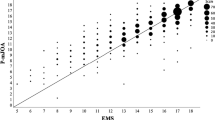Abstract
Purpose
We aimed to determine cut-offs between mild, moderate and severe myelopathy on the modified Japanese Orthopedic Association (mJOA) score.
Methods
Between December 2005 and January 2011, 757 patients with clinically diagnosed DCM were enrolled in the prospective AOSpine North America (n = 278) or International (n = 479) study at 26 sites. Functional status and quality of life were evaluated at baseline using a variety of outcome measures. Using the Nurick score as an anchor, receiver operating curve (ROC) analysis was conducted to determine cut-offs between mild, moderate and severe disease. The validity of the identified cut-offs was evaluated by examining whether patients in different severity groups differed in terms of impairment, disability, quality of life and number of signs and symptoms.
Results
A mJOA of 14 was determined to be the cut-off between mild and moderate myelopathy and a mJOA of 11 was the cut-off score between moderate and severe disease. Patients in the severe myelopathy group (n = 254) had significantly reduced quality of life and functional status and a greater number of signs and symptoms compared to patients classified as mild (n = 190) or moderate (n = 296).
Conclusions
Mild myelopathy can be defined as mJOA from 15 to 17, moderate as mJOA from 12 to 14 and severe as mJOA from 0 to 11. These categories should be adopted worldwide to standardize clinical assessment of DCM.


Similar content being viewed by others
References
Tetreault L, Goldstein CL, Arnold P, Harrop J, Hilibrand A, Nouri A, Fehlings MG (2015) Degenerative cervical myelopathy: a spectrum of related disorders affecting the aging spine. Neurosurgery 77(Suppl 4):S51–S67. doi:10.1227/NEU.0000000000000951
Nouri A, Tetreault L, Singh A, Karadimas SK, Fehlings MG (2015) Degenerative cervical myelopathy: epidemiology, genetics, and pathogenesis. Spine (Phila Pa 1976) 40(12):E675–E693. doi:10.1097/BRS.0000000000000913
Tracy JA, Bartleson JD (2010) Cervical spondylotic myelopathy. The neurologist 16(3):176–187. doi:10.1097/NRL.0b013e3181da3a29
Kalsi-Ryan S, Karadimas SK, Fehlings MG (2013) Cervical spondylotic myelopathy: the clinical phenomenon and the current pathobiology of an increasingly prevalent and devastating disorder. Neurosci: Rev J Bring Neurobiol, Neurol Psychiatry 19(4):409–421. doi:10.1177/1073858412467377
Benzel EC, Lancon J, Kesterson L, Hadden T (1991) Cervical laminectomy and dentate ligament section for cervical spondylotic myelopathy. J Spinal Disord 4(3):286–295
Kalsi-Ryan S, Singh A, Massicotte EM, Arnold PM, Brodke DS, Norvell DC, Hermsmeyer JT, Fehlings MG (2013) Ancillary outcome measures for assessment of individuals with cervical spondylotic myelopathy. Spine 38(22 Suppl 1):S111–S122. doi:10.1097/BRS.0b013e3182a7f499
Kopjar B, Tetreault L, Kalsi-Ryan S, Fehlings M (2015) Psychometric properties of the modified Japanese Orthopaedic Association scale in patients with cervical spondylotic myelopathy. Spine (Phila Pa 1976) 40(1):E23–E28. doi:10.1097/BRS.0000000000000648
Fehlings MG, Wilson JR, Kopjar B, Yoon ST, Arnold PM, Massicotte EM, Vaccaro AR, Brodke DS, Shaffrey CI, Smith JS, Woodard EJ, Banco RJ, Chapman JR, Janssen ME, Bono CM, Sasso RC, Dekutoski MB, Gokaslan ZL (2013) Efficacy and safety of surgical decompression in patients with cervical spondylotic myelopathy: results of the AOSpine North America prospective multi-center study. J Bone Joint Surg Am 95(18):1651–1658. doi:10.2106/JBJS.L.00589
Kadanka Z, Bednarik J, Vohanka S, Vlach O, Stejskal L, Chaloupka R, Filipovicova D, Surelova D, Adamova B, Novotny O, Nemec M, Smrcka V, Urbanek I (2000) Conservative treatment versus surgery in spondylotic cervical myelopathy: a prospective randomised study. Eur Spine J: Off Publ Eur Spine Soc Eur Spinal Deform Soc Eur Sect Cerv Spine Res Soc 9(6):538–544
Nurick S (1972) The natural history and the results of surgical treatment of the spinal cord disorder associated with cervical spondylosis. Brain: J Neurol 95(1):101–108
Carreon LY, Glassman SD, Campbell MJ, Anderson PA (2010) Neck disability index, short form-36 physical component summary, and pain scales for neck and arm pain: the minimum clinically important difference and substantial clinical benefit after cervical spine fusion. Spine J: Off J N Am Spine Soc 10(6):469–474. doi:10.1016/j.spinee.2010.02.007
Vernon H, Mior S (1991) The neck disability index: a study of reliability and validity. J Manipulative Physiol Ther 14(7):409–415
McHorney CA, Ware JE Jr, Raczek AE (1993) The MOS 36-Item Short-Form Health Survey (SF-36): II. Psychometric and clinical tests of validity in measuring physical and mental health constructs. Med Care 31(3):247–263
Hosmer DW, Lemeshow S, Sturdivant RX (2013) Applied logistic regression. Wiley series in probability and statistics, Third edition/edn. Wiley, Hoboken
Tetreault LA, Karpova A, Fehlings MG (2015) Predictors of outcome in patients with degenerative cervical spondylotic myelopathy undergoing surgical treatment: results of a systematic review. Eur Spine J 24(Suppl 2):236–251. doi:10.1007/s00586-013-2658-z
Tetreault L, Nouri A, Kopjar B, Cote P, Fehlings MG (2015) The minimum clinically important difference of the modified Japanese Orthopaedic Association scale in patients with degenerative cervical myelopathy. Spine (Phila Pa 1976) 40(21):1653–1659. doi:10.1097/BRS.0000000000001127
Yonenobu K, Abumi K, Nagata K, Taketomi E, Ueyama K (2001) Interobserver and intraobserver reliability of the japanese orthopaedic association scoring system for evaluation of cervical compression myelopathy. Spine (Phila Pa 1976) 26(17):1890–1894 (discussion 1895)
Acknowledgments
Michael Fehlings is supported by the Gerry and Tootsie Halbert Chair for Neural Repair and Regeneration and the DeZwirek Family Foundation. Data collection for this study was funded by AOSpine International and AOSpine North America.
Author information
Authors and Affiliations
Corresponding author
Ethics declarations
Conflict of interest
The authors have no conflicts of interest to declare.
Rights and permissions
About this article
Cite this article
Tetreault, L., Kopjar, B., Nouri, A. et al. The modified Japanese Orthopaedic Association scale: establishing criteria for mild, moderate and severe impairment in patients with degenerative cervical myelopathy. Eur Spine J 26, 78–84 (2017). https://doi.org/10.1007/s00586-016-4660-8
Received:
Revised:
Accepted:
Published:
Issue Date:
DOI: https://doi.org/10.1007/s00586-016-4660-8




